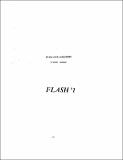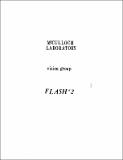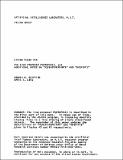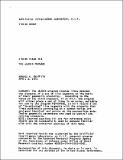Browsing AI Working Papers (1971 - 1995) by Issue Date
Now showing items 1-20 of 291
-
The L%LINES Package
(MIT Artificial Intelligence Laboratory, 1971)The program (L%LINES X Y) takes feature point output from the FP%FPOINTS program (q.v.) for horizontal and vertical scans (X and Y respectively); and outputs a list consisting of two lists of line segments, represented in ... -
Feature Point Generation Programs
(MIT Artificial Intelligence Laboratory, 1971)The programs in this set extract, from a raster of intensity values over some scene, a set of points which are adjudged to lie along the boundaries of objects in the scene. Intensities may be obtained directly from the new ... -
The Line Verifier GVERIFY1
(MIT Artificial Intelligence Laboratory, 1971)A line verifier is presented which, given the co-ordinates of the end points of the hypothesized line, returns a (possibly) more accurate version of the end points, together with an estimate of the probability that there ... -
Views on Vision
(MIT Artificial Intelligence Laboratory, 1971-02) -
The Object Partition Problem
(MIT Artificial Intelligence Laboratory, 1971-02) -
How to Use .VSCAN
(MIT Artificial Intelligence Laboratory, 1971-03) -
What's What
(MIT Artificial Intelligence Laboratory, 1971-03)An outline of the modules used in the copy demonstration, the reasons for doing robotics, and some possible directions for further work. -
Heterarchy in the M.I.T. Robot
(MIT Artificial Intelligence Laboratory, 1971-03) -
The Line Proposer P%PROPOSE1, and Additional Notes on "F%FEATUREPOINTS" and "GVERIFY1"
(MIT Artificial Intelligence Laboratory, 1971-04-02)The line proposer P%PROPOSE1 is described in the first part of this memo. It makes use of links provided by the J%JOIN program, in proposing possibly missing lines in a line drawing of simple plane-faced objects. The ... -
The J%JOIN Package
(MIT Artificial Intelligence Laboratory, 1971-04-02)The J%JOIN program creates links between the elements of a set of line segments on the basis of their geometric proximity. According to the value of the third argument, (T or NIL), the program will either place a set of ... -
What Corners Look Like
(MIT Artificial Intelligence Laboratory, 1971-06)An algorithm is presented which provides a way of telling what a given trihedral corner will look like if viewed from a particular angle. The resulting picture is a junction of two or more lines each labelled according to ... -
Shadows and Cracks
(MIT Artificial Intelligence Laboratory, 1971-06)The VIRGIN program will interpret pictures of crack and shadow free scenes by labelling them according to the Clowes/Huffman formalism. This paper indicates methods of extending the program to include cracks and shadows ... -
Two Problems in Analyzing Scenes
(MIT Artificial Intelligence Laboratory, 1971-06)This paper is based on a B.S. thesis supervised by Patrick Winston. It deals with some previously unexplored problems in the analysis of visual scenes. The scenes consist of two dimensional line drawings of simple objects ... -
Resolving Visual Ambiguity with a Probe
(MIT Artificial Intelligence Laboratory, 1971-07)The eye-hand robot at the Artificial Intelligence Laboratory now possesses the ability to occasionally copy simple configurations of blocks, using spare parts about whose presence it knows. One problem with which it cannot ... -
The Binford-Horn LINEFINDER
(MIT Artificial Intelligence Laboratory, 1971-07)This paper briefly describes the processing performed in the course of producing a line drawing from vidisector information. -
Wandering About the Top of the Robot
(MIT Artificial Intelligence Laboratory, 1971-07)Part I of this paper describes some of the new functions in the system. The discussion is seasoned here and there with parenthetical code fragments that may be ignored by readers unfamiliar with PLANNER. Part II discussed ... -
The FINDSPACE Problem
(MIT Artificial Intelligence Laboratory, 1971-08-03)The FINDSPACE problem is that of establishing a volume in space where an object of specified dimensions will fit. The problem seems to have two subproblems: the hypothesis generation problem of finding a likely spot to ... -
Progress in Extending the VIRGIN Program
(MIT Artificial Intelligence Laboratory, 1971-09)The VIRGIN program will interpret pictures of simple scenes. This paper describes a program, SINNER, which will deal with picture which contain cracks and shadows. In addition to handling pictures of this richer world, ... -
Understanding Scenes With Shadows
(MIT Artificial Intelligence Laboratory, 1971-11)The basic problem of this research is to find methods which will enable a program to construct a three dimensional interpretation from the line drawing of a scene, where the scene may have shadows and various degeneracies. ... -
Visual Position Extraction Using Stereo Eye Systems with a Relative Rotational Motion Capability
(MIT Artificial Intelligence Laboratory, 1972-01)This paper discusses the problem of context-free position estimation using a stereo vision system with moveable eyes. Exact and approximate equations are developed linking position to measureable quantities of the image-space, ...



















